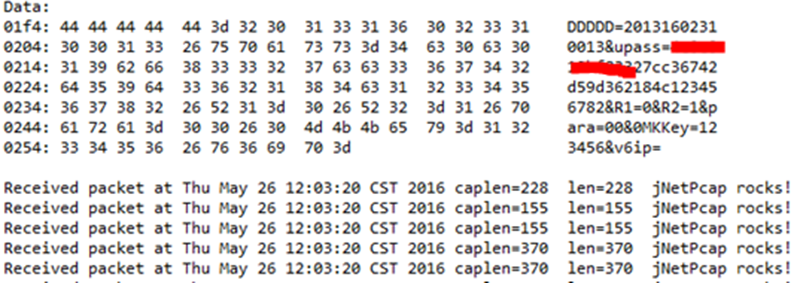TCP/IP Jnetpcap java数据抓包 小demo
jpcap java用于数据抓包的另一大jar包,由于年久失修(不更新)折腾了一下,就被我遗弃了,改用了Jnetpcap,网上资料比较少,基本只能从官网获取一下资料。
参考资料:Jnetpcap官网 http://www.jnetpcap.com/?q=examples
启动数据捕获,修改下需要捕获的网卡就可
import java.util.ArrayList; import java.util.Date; import java.util.List; import org.jnetpcap.Pcap; import org.jnetpcap.PcapIf; import org.jnetpcap.packet.PcapPacket; import org.jnetpcap.packet.PcapPacketHandler; import org.jnetpcap.packet.format.FormatUtils; import org.jnetpcap.protocol.lan.Ethernet; import org.jnetpcap.protocol.network.Ip4; public class Test { public static void main(String[] args) { List<PcapIf> alldevs = new ArrayList<PcapIf>(); // Will be filled with // NICs StringBuilder errbuf = new StringBuilder(); // For any error msgs /*************************************************************************** * First get a list of devices on this system **************************************************************************/ int r = Pcap.findAllDevs(alldevs, errbuf); if (r == Pcap.NOT_OK || alldevs.isEmpty()) { System.err.printf("Can't read list of devices, error is %s", errbuf.toString()); return; } System.out.println("Network devices found:"); // 迭代找到的所有网卡 int i = 0; for (PcapIf device : alldevs) { String description = (device.getDescription() != null) ? device .getDescription() : "No description available"; System.out.printf("#%d: %s [%s]\n", i++, device.getName(), description); } PcapIf device = alldevs.get(2); // We know we have at least 1 device 选择监听那个网卡 System.out.printf("\nChoosing '%s' on your behalf:\n", (device.getDescription() != null) ? device.getDescription() : device.getName()); /*************************************************************************** * Second we open up the selected device **************************************************************************/ // 截取长度不超过数据报max65535 int snaplen = 64 * 1024; // Capture all packets, no trucation 截断 // 混杂模式 int flags = Pcap.MODE_PROMISCUOUS; // capture all packets int timeout = 10 * 1000; // 10 seconds in millis Pcap pcap = Pcap.openLive(device.getName(), snaplen, flags, timeout, errbuf); if (pcap == null) { System.err.printf("Error while opening device for capture: " + errbuf.toString()); return; } /*************************************************************************** * Third we create a packet handler which will receive packets from the * libpcap loop. **************************************************************************/ //PacketHandler处理 /*************************************************************************** * Fourth we enter the loop and tell it to capture 10 packets. The loop * method does a mapping of pcap.datalink() DLT value to JProtocol ID, * which is needed by JScanner. The scanner scans the packet buffer and * decodes the headers. The mapping is done automatically, although a * variation on the loop method exists that allows the programmer to * sepecify exactly which protocol ID to use as the data link type for * this pcap interface. **************************************************************************/ pcap.loop(-1, new PacketHandler<String>(), "jNetPcap rocks!"); /*************************************************************************** * Last thing to do is close the pcap handle **************************************************************************/ pcap.close(); } }
捕获的数据处理,设置过滤规则
import java.util.Date; import org.jnetpcap.packet.PcapPacket; import org.jnetpcap.packet.PcapPacketHandler; import org.jnetpcap.protocol.lan.Ethernet; import org.jnetpcap.protocol.network.Ip4; import org.jnetpcap.protocol.tcpip.Http; import org.jnetpcap.protocol.tcpip.Tcp; import org.jnetpcap.protocol.tcpip.Udp; public class PacketHandler<T> implements PcapPacketHandler<T> { @Override public void nextPacket(PcapPacket packet, T user) { Http http = new Http(); if (!packet.hasHeader(http)) { return; } // System.out.printf("Received packet at %s caplen=%-4d len=%-4d %s\n", // new Date(packet.getCaptureHeader().timestampInMillis()), packet // .getCaptureHeader().caplen(), // Length // // actually // // captured // packet.getCaptureHeader().wirelen(), // Original // // length // user // User supplied object // ); String contend = packet.toString(); if (contend.contains("DDDDD")&&contend.contains("upass")) { System.out.println(contend); } // } // System.out.println( http.getPacket().toString()); // System.out.println(contend); // String hexdump=packet.toHexdump(packet.size(), false, true, // false); // byte[] data = FormatUtils.toByteArray(hexdump); Ethernet eth = new Ethernet(); // Preallocate our ethernet // header Ip4 ip = new Ip4(); // Preallocat IP version 4 header Tcp tcp = new Tcp(); Udp udp = new Udp(); // Http http=new Http(); // if (packet.hasHeader(eth)) { // System.out.printf("ethernet.type=%X\n", eth.type()); // } // // if (packet.hasHeader(ip)) { // System.out.printf("ip.version=%d\n", ip.version()); // } } }
不足之处:截取的数据包数据是像sniff那样,之后就查不到如何只获取右边编码后的数据了






【推荐】国内首个AI IDE,深度理解中文开发场景,立即下载体验Trae
【推荐】编程新体验,更懂你的AI,立即体验豆包MarsCode编程助手
【推荐】抖音旗下AI助手豆包,你的智能百科全书,全免费不限次数
【推荐】轻量又高性能的 SSH 工具 IShell:AI 加持,快人一步